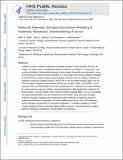Molecular Pathways: Receptor Ectodomain Shedding in Treatment, Resistance, and Monitoring of Cancer
Author(s)
Miller, Miles A.; Sullivan, Ryan J.; Lauffenburger, Douglas A
Downloadnihms-831937.pdf (470.1Kb)
OPEN_ACCESS_POLICY
Open Access Policy
Creative Commons Attribution-Noncommercial-Share Alike
Terms of use
Metadata
Show full item recordAbstract
Proteases known as sheddases cleave the extracellular domains of their substrates from the cell surface. The A Disintegrin and Metalloproteinases ADAM10 and ADAM17 are among the most prominent sheddases, being widely expressed in many tissues, frequently overexpressed in cancer, and promiscuously cleaving diverse substrates. It is increasingly clear that the proteolytic shedding of transmembrane receptors impacts pathophysiology and drug response. Receptor substrates of sheddases include the cytokine receptors TNFR1 and IL6R; the Notch receptors; type-I and -III TGFβ receptors; receptor tyrosine kinases (RTK) such as HER2, HER4, and VEGFR2; and, in particular, MET and TAM-family RTKs AXL and Mer (MerTK). Activation of receptor shedding by mechanical cues, hypoxia, radiation, and phosphosignaling offers insight into mechanisms of drug resistance. This particularly holds for kinase inhibitors targeting BRAF (such as vemurafenib and dabrafenib) and MEK (such as trametinib and cobimetinib), along with direct sheddase inhibitors. Receptor proteolysis can be detected in patient fluids and is especially relevant in melanoma, glioblastoma, lung cancer, and triplenegative breast cancer where RTK substrates, MAPK signaling, and ADAMs are frequently dysregulated. Translatable strategies to exploit receptor shedding include combination kinase inhibitor regimens, recombinant decoy receptors based on endogenous counterparts, and, potentially, immunotherapy.
Date issued
2016-11Department
Massachusetts Institute of Technology. Department of Biological EngineeringJournal
Clinical Cancer Research
Publisher
American Association for Cancer Research (AACR)
Citation
Miller, Miles A. et al. “Molecular Pathways: Receptor Ectodomain Shedding in Treatment, Resistance, and Monitoring of Cancer.” Clinical Cancer Research 23, 3 (November 2016): 623–629 © 2016 AACR
Version: Author's final manuscript
ISSN
1078-0432
1557-3265